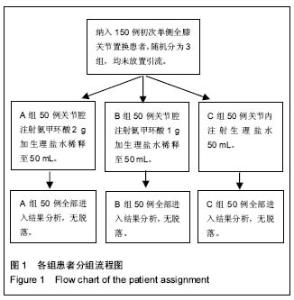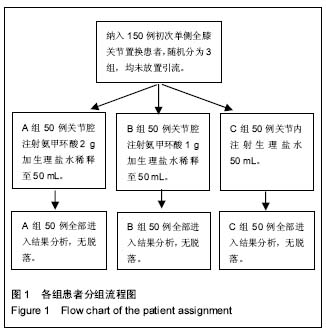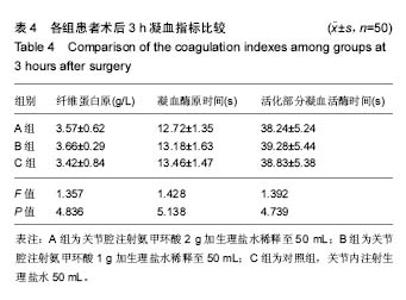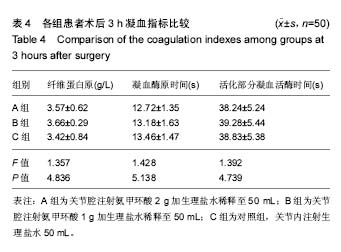Chinese Journal of Tissue Engineering Research ›› 2017, Vol. 21 ›› Issue (35): 5583-5588.doi: 10.3969/j.issn.2095-4344.2017.35.002
Previous Articles Next Articles
Local application of different doses of tranexamic acid without drainage reduces blood loss after total knee arthroplasty
Duan Guo-qing1, Ren Chun-feng2
- 1Department of Bone and Joint, Affiliated Hospital of Jining Medical University, Jining 272029, Shandong Province, China; 2Department of Rheumatism and Immunity, Jining No.1 People’s Hospital, Jining 272000, Shandong Province, China
-
Online:2017-12-18Published:2018-01-02 -
Contact:Ren Chun-feng, Master, Attending physician, Department of Rheumatism and Immunity, Jining No.1 People’s Hospital, Jining 272000, Shandong Province, China -
About author:Duan Guo-qing, M.D., Associate chief physician, Department of Bone and Joint, Affiliated Hospital of Jining Medical University, Jining 272029, Shandong Province, China
CLC Number:
Cite this article
Duan Guo-qing, Ren Chun-feng. Local application of different doses of tranexamic acid without drainage reduces blood loss after total knee arthroplasty [J]. Chinese Journal of Tissue Engineering Research, 2017, 21(35): 5583-5588.
share this article
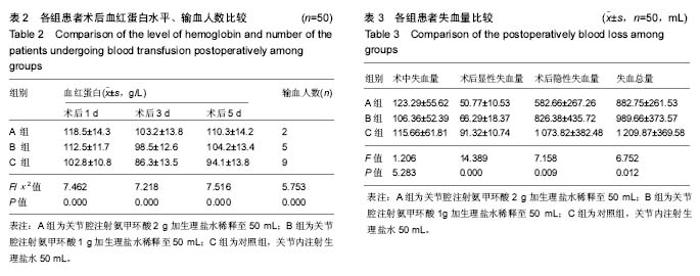
2.2 各组患者术后血红蛋白水平及输血人数比较 3组患者在术后第1,3,5天的血红蛋白浓度与术前比较下降明显;在术后各时间点,3组间比较差异有显著性意义(F=7.218-7.516,P=0.000);术后3组患者输血人数分别为2,5,12例,差异有显著性意义(χ2=5.753,P=0.000),见表2。 2.3 各组患者失血量比较 3组患者术中失血量差异无显著性意义(F=1.206,P=5.283)。3组患者术后显性失血量比较差异有显著性意义(F=14.389,P=0.000),术后隐性失血量比较差异有显著性意义(F=7.158,P=0.009),术后总失血量比较差异有显著性意义(F=6.752,P=0.012),见表3。"
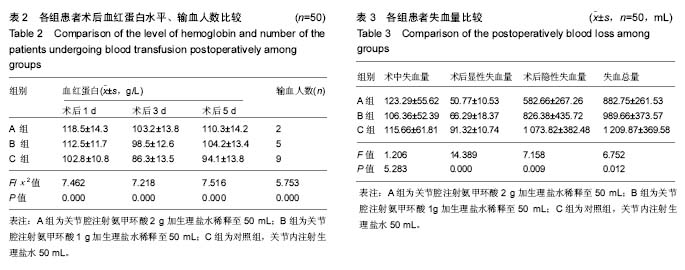
| [1] Ebert JR,Munsie C,Joss B, et al.Guidelines for the early restoration of active knee flexion after total knee arthroplasty: Implications for rehabilitation and early intervention.Arch Phys Med Rehabil. 2014;95(6): 1135-1140. [2] Seo JG,Moon YW,Park SH,et al. The comparative efficacies of intra-articular and IV tranexamicacid for reducing blood loss during total knee arthroplasty.Knee Surg Sports Traumatol Arthrosc. 2013;21(8):1869-1874. [3] Sabatini L, Atzori F. Topical intraarticular and intravenous tranexamic acid to reduce blood loss in total knee arthroplasty. Ann Transl Med.2015;3(S1): S18.doi: 10.3978/j.issn. 2305-5839. 2015.02.25.[4] Wayne TN, Nima M, Jason JD. Topical vs Intravenous Tranexamic Acid in Primary Total Hip Arthroplasty: A Double-Blind, Randomized Controlled Trial. J Arthroplasty. 2016;31(5):1022-1026.[5] CRASH-2 trial collaborators,Shakur H,Robert I,et al.Effects of tranexamic acid ondeath, vascular occlusive events,and blood transfusion in trauma patients with significant Haemorrhage (CRASH-2): arandomised, placebo-controlled trial.Lancet. 2010;376(9734):23-32.[6] Bagsby DT,Samujh CA,Vissing JL,et al.Tranexamic acid decreases incidence of blood transfusion in simultaneous bilateral total knee arthroplasty. J Arthroplasty. 2015;30(12): 2106-2109.[7] Yang ZG,Chen WP,Wu LD. Effectiveness and safety of tranexamic acid in reducing blood loss in total knee arthroplasty:a meta-analysis. J Bone Joint Surg Am. 2012;94(13):1153-1159.[8] Bourke DL, Smith TC. Estimating allowable hemodihtion. Anaesthesiology. 1974;41:609-612.[9] Nadler SB, Hidalgo JU, Bloch T. Prediction of blood volume in normal human adults. Surgery. 1962;51:224-232.[10] 闵令田,翁文杰,邱勇,等. 关节腔内灌注氨甲环酸降低全膝关节置换手术出血的前瞻性随机对照研究[J].中华关节外科杂志, 2014,8(4):482-486.[11] Bidolegui F, Arce G, Lugones A, et al. Tranexamic acid reduces blood loss and transfusion in patients undergoingtotal knee arthroplasty without tourniquet:a prospective randomized controlled trial. Orthop J. 2014;8(1): 250-254.[12] 席少华, 周朝波, 赵桂林.氨甲环酸在全膝关节置换术中局部应用和静脉应用的止血效果比较[J].实用药物和临床,2015,18(4):762-765.[13] Roche M,Law TY,Rosas S, et al. Transfusion requirements following total knee arthroplasty in patients with preexisting blood dyscrasia.Surg Technol Int. 2017;30:435-440. [14] 马金辉,孙伟,高福强,等.关节腔注射氨甲环酸单侧全膝关节置换者的失血量及肢体周径变化:随机对照[J]. 中国组织工程研究, 2014,18(35): 5577-5582.[15] Balasubramanian N,Natarajan GB,Prakasam S.Prospective study to compare intra-articular versus intravenous tranexamic acid in reducing post-operative blood loss in staged bilateral total knee arthroplasty.Malays Orthop J. 2016;10(3):7-11.[16] Evangelista PJ,Aversano MW,Koli E,et al.Effect of of tranexamic acid on transfusion rates following total joint arthroplasty:A cost and comparative effectiveness analysis. Orthop Clin North Am. 2017;48(2):109-115.[17] Aydin BK,Durgut F,Erkocak öF,et al.Other benefits of intra-articular injection of tranexamic acid in primary total knee arthroplasty apart from reducing blood transfusion rates. Eklem Hastalik Cerrahisi. 2017;28(1):25-29.[18] Ralley FE, Berta D, Binns V, et al. One intraoperative dose of tranexamic acid for patients having primary hip of knee arthroplasty. Clin Orthop Relat Res. 2010;468(7):1905-1911.[19] Alshryda S, Sukeik M, Sarda P,et al. A systematic review and meta-analysis of the topical administration of tranexamic acid in total hip and knee replacement. Bone Joint J. 2014;96-B(8): 1005-1015.[20] Zhang Y,Zhang JW,Wang BH.Efficacy of tranexamic acid plus drain-clamping to reduce blood loss in total knee arthroplasty: a meta-analysis.Medicine. 2017;96(26):e7363.[21] Tian P,Liu WB,Li ZJ,et al.The efficacy and safety of tranexamic acid in revision in total knee arthroplasty:a meta-analysis.BMC Musculoskelet Discord.2017; 18(1):273.[22] Yu Z,Yao L,Yang Q.Tranexamic acid plus diluted-epinephrine venrsus tranexamic acid alone for blood loss in total joint arthroplasty:a meta-analysis.Medicine. 2017;96(24):e7095.[23] Soni A, Saini R, Gulati A, et al. Comparison between intravenous and intra-articular regimens of tranexamic acid in reducing blood loss during total knee arthroplasty. J Arthroplasty. 2014;29(8):1525-1527.[24] 王浩然,董金波,李江华,等. 全膝关节置换中静脉和局部应用氨甲环酸的止血效果对比[J].重庆医学,2016,45(30):4249-4251.[25] Goyal N,Chen DB,Harris IA,et al.Intravenous vs intra-articular tranexamic acid in total knee arthroplasty:a randomized double-blind trial.J Arthroplasty. 2017;32(1):28-32.[26] Zhao-Yu C, Yan G, Wei C, et al.Reduced blood loss after intra-articular tranexamic acid injection during total knee arthroplasty: a meta-analysis of the literature. Knee Surg Sports Traumatol Arthrosc. 2014;22(12):3181-3190.[27] Loxano M,Basora M,Peidro L,et al.Effectiveness and safety of tranexamic acid administration during total knee arthroplasty. Vox Sanguinis. 2008;95(1):39-44.[28] Kim TK,Chang CB,Koh IJ.Pratical issues for the ues of tranexamic acid in total knee arthroplasty:a systematic review. Knee Surg Sports Traumatol Arthrosc. 2014;22(8):1849-1858.[29] Molloy DO,Archbold HA,Ogonda L,et al.Comparison of topical fibrin spray and tranexamic acid on blood lose after total knee replacement:a prospective randomised controlled trial.J Bone Joint Surg(Br). 2007;89(3):306-309.[30] 冯贵喜,刘军,张福江,等. 氨甲环酸局部应用对单侧全膝关节置换术后隐性失血量的影响[J].中华骨科杂志, 2016, 36(3): 151-155.[31] Mutsuzaki H,Ikeda K.Intra-articular injection of tranexamic acid via a drain plus drain-clamping to reduce blood loss in cementless total knee arthroplasty.J Orthop Surg Res. 2012; (7):1-6.[32] Jiang B,Kao M,Bohm MT,et al.Intra-articular injection of tranexamic acid to reduce blood loss after total knee arthroplasty. J Orthop Surg(Hong Kong). 2014;22(2):146-149.[33] Kosins AM,Schol T,Cetinkaya M,et al.Evidence-based value of subcutaneous surgical wound drainage: The largest systematic review and meta-analysis. Plast Reconstr Surg. 2013;132(2): 443-450.[34] Demirkale L,Tecimel O,Sesen H,et al. Nondrainage decreases blood transfusion need and infection rate in bilateral total knee arthroplasty.J Arthroplasty.2014;29(5): 993-997.[35] 董盼锋,陈跃平,康杰,等.人工膝关节置换的引流效应[J].中国组织工程研究,2014,18(17):2649-2654.[36] 张纪,张洪. 人工膝关节置换术后放置引流与否的对比研究[J].中华外科杂志,2011,49(12):1119-1122. |
| [1] | Wang Jianping, Zhang Xiaohui, Yu Jinwei, Wei Shaoliang, Zhang Xinmin, Xu Xingxin, Qu Haijun. Application of knee joint motion analysis in machanism based on three-dimensional image registration and coordinate transformation [J]. Chinese Journal of Tissue Engineering Research, 2022, 26(在线): 1-5. |
| [2] | Zhuang Zhikun, Wu Rongkai, Lin Hanghui, Gong Zhibing, Zhang Qianjin, Wei Qiushi, Zhang Qingwen, Wu Zhaoke. Application of stable and enhanced lined hip joint system in total hip arthroplasty in elderly patients with femoral neck fractures complicated with hemiplegia [J]. Chinese Journal of Tissue Engineering Research, 2022, 26(9): 1429-1433. |
| [3] | Li Canhui, Wu Zhengjie, Zeng Yanhui, He Yinghao, Situ Xiaopeng, Du Xuelian, Hong Shi, He Jiaxiong. Advantage and disadvantage of robot-assisted sacroiliac screw placement and traditional fluoroscopy in orthopedic surgery [J]. Chinese Journal of Tissue Engineering Research, 2022, 26(9): 1434-1438. |
| [4] | Zhang Lichuang, Xu Hao, Ma Yinghui, Xiong Mengting, Han Haihui, Bao Jiamin, Zhai Weitao, Liang Qianqian. Mechanism and prospects of regulating lymphatic reflux function in the treatment of rheumatoid arthritis [J]. Chinese Journal of Tissue Engineering Research, 2022, 26(9): 1459-1466. |
| [5] | Zhang Jichao, Dong Yuefu, Mou Zhifang, Zhang Zhen, Li Bingyan, Xu Xiangjun, Li Jiayi, Ren Meng, Dong Wanpeng. Finite element analysis of biomechanical changes in the osteoarthritis knee joint in different gait flexion angles [J]. Chinese Journal of Tissue Engineering Research, 2022, 26(9): 1357-1361. |
| [6] | Yao Xiaoling, Peng Jiancheng, Xu Yuerong, Yang Zhidong, Zhang Shuncong. Variable-angle zero-notch anterior interbody fusion system in the treatment of cervical spondylotic myelopathy: 30-month follow-up [J]. Chinese Journal of Tissue Engineering Research, 2022, 26(9): 1377-1382. |
| [7] | Wu Bingshuang, Wang Zhi, Tang Yi, Tang Xiaoyu, Li Qi. Anterior cruciate ligament reconstruction: from enthesis to tendon-to-bone healing [J]. Chinese Journal of Tissue Engineering Research, 2022, 26(8): 1293-1298. |
| [8] | An Weizheng, He Xiao, Ren Shuai, Liu Jianyu. Potential of muscle-derived stem cells in peripheral nerve regeneration [J]. Chinese Journal of Tissue Engineering Research, 2022, 26(7): 1130-1136. |
| [9] | Zhang Jinglin, Leng Min, Zhu Boheng, Wang Hong. Mechanism and application of stem cell-derived exosomes in promoting diabetic wound healing [J]. Chinese Journal of Tissue Engineering Research, 2022, 26(7): 1113-1118. |
| [10] | Liu Dongcheng, Zhao Jijun, Zhou Zihong, Wu Zhaofeng, Yu Yinghao, Chen Yuhao, Feng Dehong. Comparison of different reference methods for force line correction in open wedge high tibial osteotomy [J]. Chinese Journal of Tissue Engineering Research, 2022, 26(6): 827-831. |
| [11] | Shao Yangyang, Zhang Junxia, Jiang Meijiao, Liu Zelong, Gao Kun, Yu Shuhan. Kinematics characteristics of lower limb joints of young men running wearing knee pads [J]. Chinese Journal of Tissue Engineering Research, 2022, 26(6): 832-837. |
| [12] | Huang Hao, Hong Song, Wa Qingde. Finite element analysis of the effect of femoral component rotation on patellofemoral joint contact pressure in total knee arthroplasty [J]. Chinese Journal of Tissue Engineering Research, 2022, 26(6): 848-852. |
| [13] | Yuan Jing, Sun Xiaohu, Chen Hui, Qiao Yongjie, Wang Lixin. Digital measurement and analysis of the distal femur in adults with secondary knee valgus deformity [J]. Chinese Journal of Tissue Engineering Research, 2022, 26(6): 881-885. |
| [14] | Zhou Jianguo, Liu Shiwei, Yuan Changhong, Bi Shengrong, Yang Guoping, Hu Weiquan, Liu Hui, Qian Rui. Total knee arthroplasty with posterior cruciate ligament retaining prosthesis in the treatment of knee osteoarthritis with knee valgus deformity [J]. Chinese Journal of Tissue Engineering Research, 2022, 26(6): 892-897. |
| [15] | Yang Yang, Li Naxi, Zhang Jian, Wang Mian, Gong Taifang, Gu Liuwei. Effect of tourniquet combined with exsanguination band use on short-term lower extremity venous thrombosis after knee arthroscopy [J]. Chinese Journal of Tissue Engineering Research, 2022, 26(6): 898-903. |
| Viewed | ||||||
|
Full text |
|
|||||
|
Abstract |
|
|||||
